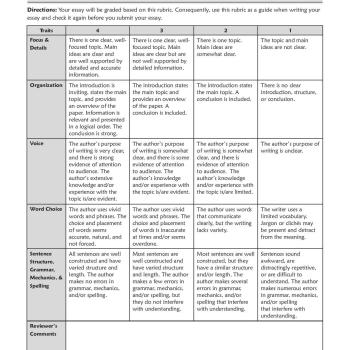Essay Rubric

About this printout
This rubric delineates specific expectations about an essay assignment to students and provides a means of assessing completed student essays.
Teaching with this printout
Grading rubrics can be of great benefit to both you and your students. For you, a rubric saves time and decreases subjectivity. Specific criteria are explicitly stated, facilitating the grading process and increasing your objectivity. For students, the use of grading rubrics helps them to meet or exceed expectations, to view the grading process as being “fair,” and to set goals for future learning.
In order to help your students meet or exceed expectations of the assignment, be sure to discuss the rubric with your students when you assign an essay. It is helpful to show them examples of written pieces that meet and do not meet the expectations. As an added benefit, because the criteria are explicitly stated, the use of the rubric decreases the likelihood that students will argue about the grade they receive. The explicitness of the expectations helps students know exactly why they lost points on the assignment and aids them in setting goals for future improvement.
More ideas to try
- Routinely have students score peers’ essays using the rubric as the assessment tool. This increases their level of awareness of the traits that distinguish successful essays from those that fail to meet the criteria. Have peer editors use the Reviewer’s Comments section to add any praise, constructive criticism, or questions.
- Alter some expectations or add additional traits on the rubric as needed. Students’ needs may necessitate making more rigorous criteria for advanced learners or less stringent guidelines for younger or special needs students. Furthermore, the content area for which the essay is written may require some alterations to the rubric. In social studies, for example, an essay about geographical landforms and their effect on the culture of a region might necessitate additional criteria about the use of specific terminology.
- After you and your students have used the rubric, have them work in groups to make suggested alterations to the rubric to more precisely match their needs or the parameters of a particular writing assignment.